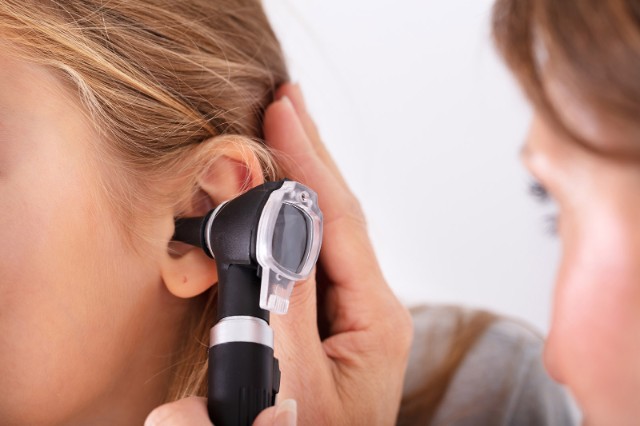A new type of ultrasound transducer from Fraunhofer should soon be delivering a fast and reliable diagnosis of infection of the middle ear. A U.S. company and the Fraunhofer Institute for Photonic Microsystems IPMS are collaborating on the development and application of this technology. The transducer is integrated in an otoscope and helps physicians decide whether a course of antibiotics is really necessary.
In cases of infection of the middle ear, particularly among infants and young children, antibiotics are often the remedy of choice. Yet the equipment used to diagnose this condition has stood still for a number of decades. As a result, doctors can only deliver a diagnosis that is subjective and unreliable. On average, diagnostic accuracy for this condition is as low as 50 percent, not least when it comes to distinguishing between a bacterial and viral infection. This means that lots of children are prescribed antibiotics unnecessarily. This, in turn, is feeding a growing resistance to antibiotics worldwide. However, a new type of ultrasound transducer developed at the Fraunhofer Institute for Photonic Microsystems IPMS can resolve this dilemma. It employs air-coupled ultrasound to enable a precise diagnosis of infection of the middle ear, a condition also known as otitis media. The U.S. company OtoNexus Medical Technologies has developed an otoscope incorporating this technology. Their device is now undergoing clinical studies. Pediatricians and other doctors will be able to use it to examine the external auditory canal and, more particularly, the area behind the ear drum. In a matter of seconds, they will be able to tell whether there is air or fluid in the middle ear, and to characterize this fluid. This will permit them to distinguish between different stages of the illness and thereby determine the appropriate treatment.
Echo signal reveals the degree of infection
“The classic otoscope is an optical system and hasn’t changed in decades,” explains Dr. Sandro Koch, a physicist at Fraunhofer IPMS in Dresden. “But when fitted with our ultrasound transducer, which is both a transmitter and receiver, it develops new functions.” The transducer emits ultrasonic pulses and captures the echo reflected from the eardrum. On the basis of this data, the device generates a reading that tells the doctor about the degree of infection.
The innovative transducer is designed to operate via the medium of air. It features a capacitor formed by two electrodes separated by a small air-filled gap. “One of these electrodes is flexible,” Koch explains. “We use the vibrations of this electrode to transmit ultrasonic pulses. When the echo from this signal strikes a flexible membrane, the resultant vibration is converted into a detectable electrical signal.” Proprietary software developed by industry partner OtoNexus analyzes the echo signal. Initial clinical studies have corroborated the accuracy of the analysis. In other words, the reading provides physicians with a reliable indication for middle-ear infection.
Miniaturized and suitable for mass production
The ultrasound transducer is a socalled CMUT (capacitive micromachined ultrasonic transducer). It is produced on a silicon wafer by means of special microelectromechanical systems (MEMS) technology developed at Fraunhofer IPMS. The transducer has a low power consumption and can be mass-produced cheaply. “And, unlike traditional ceramic piezoelectric ultrasound transducers, our MEMS transducer can be miniaturized,” says Koch. “That’s a major advantage here, because it means the CMUT can be incorporated much more easily in an otoscope.”
The new otoscope featuring a Fraunhofer CMUT is currently at the prototype stage with market launch anticipated within a few years.
Uses of the MEMS transducer are not restricted to medical applications. For instance, ultrasound transducers can also be incorporated in smartphones and tablets to enable gesture control or installed in vehicles to control onboard infotainment systems. They can also deliver various functions in robotics, including distance measurement.
See Full Press Release: Ultrasound sensor aids diagnosis of middle-ear infection
Written by: Fraunhofer

Legacy MedSearch has more than 30 years of combined experience recruiting in the medical device industry. We pride ourselves on our professionalism and ability to communicate quickly and honestly with all parties in the hiring process. Our clients include both blue-chip companies and innovative startups within the MedTech space. Over the past 10 years, we have built one of the strongest networks of device professionals ranging from sales, marketing, research & , quality & regulatory, project management, field service, and clinical affairs.
We offer a variety of different solutions for hiring managers depending on the scope and scale of each individual search. We craft a personalized solution for each client and position with a focus on attracting the best possible talent in the shortest possible time frame.
Are you hiring?
Contact us to discuss partnering with Legacy MedSearch on your position.

